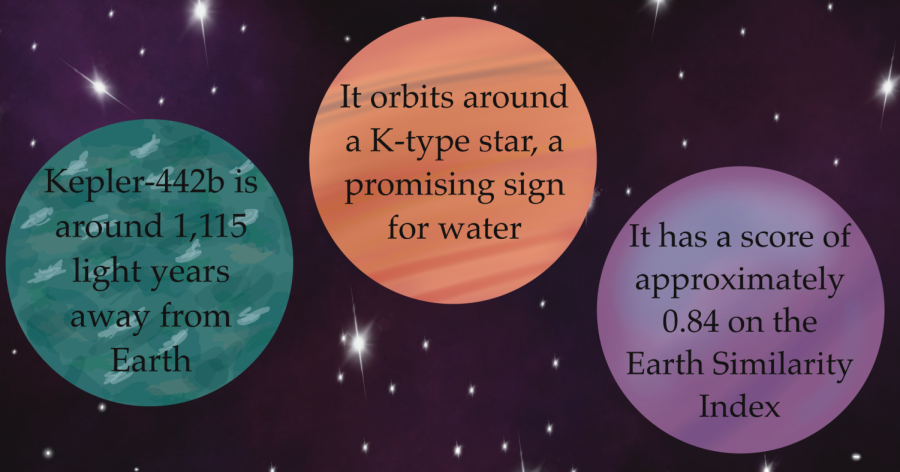New exoplanet one of two with possible habitable conditions
March 28, 2023
Kepler-442b is one of two most Earth-like exoplanets discovered to date that “could be within the ‘Goldilocks zone’ that would permit life to exist,” according to AS USA.
Discovered in 2015 by NASA’s Kepler spacecraft, Kepler-442b is a likely rocky exoplanet that is 33% bigger than our planet and is estimated to be around 1100 to 1200 light years away from Earth.
Classified as a “super-earth,” Kepler-442b orbits around a K-type star that is cooler than our sun, but the exoplanet lies in its star’s habitable zone, where liquid water could possibly exist. Throughout time, experts have discovered a growing number of planets that fit various criteria of what could sustain to life. Still Kepler-442b has been a notable exoplanet, one that has caught the online astronomy community’s attention as a planet more habitable than Earth, according to a study by astronomers at the University of Washington.
The Earth Similarity Index (ESI), a scale used to quantitatively contrast Earth with other planets, classifies any planet with a score above 0.80 as an Earth-like planet. The index considers factors such as surface temperature, density, radius and radius escape velocity — but not habitability. Kepler-442b is approximately 0.84 to 0.85 on the Earth Similarity Index. This makes Kepler-442b quite similar to Earth, which scores 1.00 on the ESI. For context, Mars has an ESI of 0.73.
When it comes to habitability, based on a study published in the Monthly Notices of the Royal Astronomical Society, researchers found Kepler-442b receives close to enough radiation from its star to sustain a large biosphere. This is important to have because photosynthesis is crucial for developing an oxygen-based atmosphere for facilitating complex biospheres like those on Earth.
Furthermore, the possibility of this planet being habitable is also supported based on a “Habitability Index for Transiting Planets” made by astronomers at the University of Washington in 2015 that gave Kepler-442b a higher rating of habitability than Earth. This does not necessarily mean the planet can be inhabited, but that there are better conditions for habitability; however, even with these encouraging indicators that Kepler-442b may be able to sustain life, more observations would absolutely be necessary to truly affirm this belief.
“I did some calculations to see how observable this planet is, how easy it is for us to observe it with our current instrumentation, which is the James Webb telescope, and what I discovered is that it’s not too bad, but it’s not great [based on] this index; let’s just call it the observability index in term of transmission spectroscopy,” Dr. Xinting Yu, an assistant professor in the Department of Physics and Astronomy, said.
Yu’s research primarily deals with applying experimental material science approaches to characterize and comprehend planetary material.
“You really would say for this kind of planet, you want maybe an index of ten, so you don’t need that many transits to get a good signal-to-noise ratio, but for this planet, it’s around two, so it’s a little bit lower, but it’s not too bad because it [is] very similar to the Trappist system planets,” Yu explained.
According to Yu, the Trappist system is currently a focal point for research into the search for other planets with life, “but people are observing this system with the James Webb telescope right now with an index of two [which] if we can do those systems, we can do the Kepler system.”







